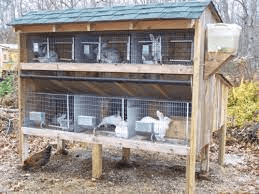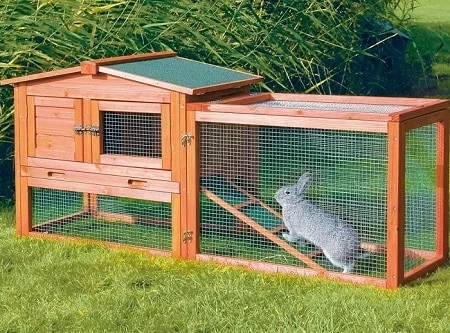Rabbit hutch equipment consists of items like some home-made rabbit drinkers and food troughs, water trough and food trough, roughage rack, kindling box, etc. In addition, there may be a need for a transport box and a storage facility for food and other items.
A rabbit hutch is essentially a cozy and secure haven designed to meet the specific needs of our furry, long-eared friends in the world of rabbit farming.
Picture it as a comfortable home tailored to the natural behaviors and well-being of rabbits, providing both shelter and a space for them to exhibit their innate behaviors.
A rabbit hutch is more than just a structure; it’s a carefully crafted space that prioritizes the comfort, safety, and natural instincts of rabbits. From protection against the elements to opportunities for exploration, a rabbit hutch serves as a vital component in creating a conducive and caring environment for our floppy-eared companions in the world of agriculture.
Let’s break down the key elements that make a rabbit hutch an essential component in rabbit husbandry:
1. Cozy Shelter: At its core, a rabbit hutch is a shelter that offers protection from the elements. Whether it’s shielding rabbits from rain, wind, or intense sunlight, the hutch provides a secure and climate-appropriate environment. The construction typically includes a solid roof and walls to create a safe retreat for the rabbits.
2. Ample Ventilation: Good air circulation is vital for the health of rabbits, and a well-designed hutch ensures proper ventilation. This prevents the buildup of humidity and odors, contributing to a fresh and comfortable living space for the rabbits.
3. Spacious Living Quarters: A rabbit hutch isn’t just about confinement; it’s about providing enough space for rabbits to move around, stretch, and exhibit natural behaviors.
The living quarters include a comfortable area for resting, a separate space for feeding, and sometimes even elevated platforms or ramps for a bit of bunny exploration.
4. Easy Accessibility: Accessibility is key for both rabbits and caretakers. A well-designed hutch allows easy access for feeding, cleaning, and monitoring the health of the rabbits. Features such as removable trays or hinged doors contribute to the convenience of daily care.
5. Chew-Resistant Construction: Rabbits are notorious chewers, and a quality hutch takes this into account. Constructed with materials resistant to the persistent nibbling of rabbit teeth, the hutch ensures durability and longevity.
6. Protection Against Predators: Security is a top priority in a rabbit hutch. Whether it’s built with a sturdy frame or a secure wire mesh, the hutch is designed to keep potential predators at bay, ensuring the safety of the rabbits.
7. Enrichment Opportunities: Recognizing the active and curious nature of rabbits, a thoughtful hutch design may incorporate elements for enrichment. This could include hiding spots, toys, or even a digging area, providing mental stimulation and preventing boredom.
8. Easy to Clean: Maintaining a clean and hygienic environment is essential for rabbit health. A well-designed hutch facilitates easy cleaning with features such as removable trays, access points for sweeping, and materials that are resistant to stains and odors.
Read Also: Types of Rabbit Housing
Rabbit Hutch Equipment Requirements

For water and food troughs the requirements are;
It should be impossible to tilt over.
It should have adequate size and depth.
It should discourage scratching out of contents. It must not cause injury to the rabbit.
It should be cheap and can be constructed locally.
Forage racks should be fitted inside the hutch and it should allow the rabbit full access and not limit food intake.
Kindling boxes should:
Provide a secure, draught-proof dry container in which the doe can kindle;
Prevent the young rabbits from leaving until they are at least 2-3 weeks old.
Maintenance of Rabbit Hutches and Equipment

Proper maintenance includes the following:
Cleaning of hutch and equipment every 2-3 days;
Complete cleaning between litters using soap and water and if possible disinfectants.
This should be followed by complete drying and disinfection in direct sunlight;
Checking and repairing loose boards, tins, or wires which may allow the rabbits to escape or drop through or predators to enter.
Checking for the development of sharp edges in hutches and on equipment that may cause injury.
In conclusion, regardless of the type of rabbit housing method and the equipment used the above-mentioned requirements on housing and equipment have to be fulfilled.
Any rabbit hutch should provide adequate space and protection for the rabbit and also convenience to the rabbit keeper.
Basically, there are two types of housing these are outdoor hutches – this is kept outside all the time. Indoor hutches – these are kept inside a house or open shed.
Read Also: Principles of Housing and Sanitation for Rabbits

Rabbit hutch equipment consists of four items, water trough; food trough; roughage rack; kindling box.
Equipment requirements: For water and food troughs it should be impossible to tilt over. It should have adequate size and depth. It should discourage scratching out of contents. It must not cause injury to the rabbit.
It should be cheap and can be constructed locally. Forage racks should be fitted inside the hutch and it should allow the rabbit full access and not limit food intake.
Kindling boxes should: provide a secure, draught-proof dry container in which the doe can kindle; prevent the young rabbits from leaving until they are at least 2-3 weeks old.
Maintenance of hutches and equipment includes cleaning of hutch and equipment every 2-3 days; complete cleaning between litters using soap and water and if possible disinfectants.
This should be followed by complete drying and disinfection in direct sunlight; checking and repairing loose boards, tins, or wires which may allow the rabbits to escape or drop through o predators to enter;
Checking for the development of sharp edges in hutches and on equipment that may cause injury.
In conclusion, skills needed for a successful rabbit operation, therefore, include Observation, examination, record keeping, hutch design, building and siting, food identification, selection, production and storage, and good management.
Observation is a skill that comes with practice but can be developed with the help of questions to be used each time you visit the rabbit unit.
Rabbit examination is required after a new rabbit is being bought or rabbits are being checked prior to selection for breeding.
Weighing is done to check on their growth and their general condition. Nail trimming, rabbits’ nails need to be trimmed from time to time.
Identification: This is a way and means of recognizing one’s animals (rabbits) and differentiating between one’s animals (rabbits) from another farmer’s own and differentiating between individual animals (rabbits).
There are several methods employed to achieve this. Writing in the ear, Labels, Ear-notching.
Record keeping and analysis: It is necessary to keep records as the number increases. Two types of records are required. Financial records and Animal records.
Read Also: Selection for Rabbit Breeding Process and Rabbit Mating
Read Also: Benefits of Passion Flowers
